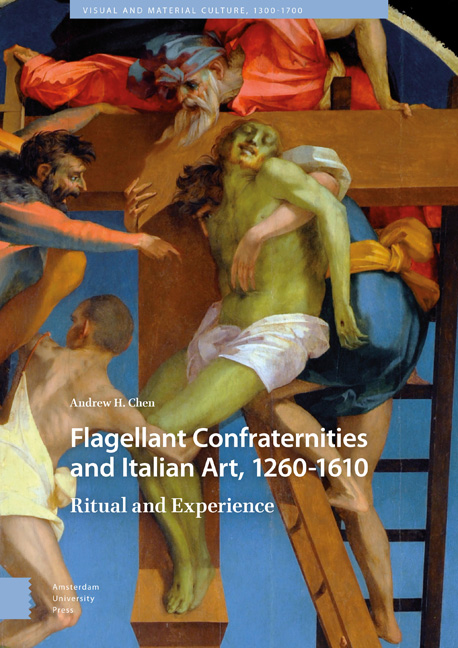Book contents
- Frontmatter
- Deduction
- Contents
- Abbreviations
- List of Illustrations
- Acknowledgements
- Introduction
- Part I Art and Ritual, to 1450
- 1 Flagellation and Its Settings
- 2 Images at Entrances, and Ascesis
- 3 Mass
- 4 Comforting
- 5 Processions
- Part II Transformations
- 6 Changes in Ritual Before Trent
- 7 Changes in imagery before Trent: Sansepolcro and Volterra
- 8 After Trent: Florence and Milan
- Epilogue: Global Flagellation
- Bibliography
- Index of Illuminated Manuscripts (by location)
- Index of Paintings (by location)
- Index of Topics
7 - Changes in imagery before Trent: Sansepolcro and Volterra
Published online by Cambridge University Press: 11 December 2020
- Frontmatter
- Deduction
- Contents
- Abbreviations
- List of Illustrations
- Acknowledgements
- Introduction
- Part I Art and Ritual, to 1450
- 1 Flagellation and Its Settings
- 2 Images at Entrances, and Ascesis
- 3 Mass
- 4 Comforting
- 5 Processions
- Part II Transformations
- 6 Changes in Ritual Before Trent
- 7 Changes in imagery before Trent: Sansepolcro and Volterra
- 8 After Trent: Florence and Milan
- Epilogue: Global Flagellation
- Bibliography
- Index of Illuminated Manuscripts (by location)
- Index of Paintings (by location)
- Index of Topics
Summary
The first half of this book examined modes of reception for a variety of images from the fourteenth and fifteenth centuries. These responses to art were elucidated not only with reference to ceremonial texts but also through analyses of donor portraits as representations of ideal spectatorship. It was found that there are some interesting correspondences between textual and visual sources. One type of liturgy common in Florence involved extinguishing candles exactly at the moment of flagellation, when spoken or sung word directed meditations on the Passion. This was seen to relate to the fact that some images have flagellant donors looking away from the artwork's principal subject and/or wearing hoods without eyeholes. Both can be said of the figures in the Man of Sorrows by Cenni di Francesco (Fig. 5). Flagellant confraternities found various ways of disciplining the eye: statutes obliged them to look down and away from images, darkness and hoods covering faces forced them to use their inner powers of vision. This meant also that images like the Man of Sorrows dematerialized and materialized during rituals. Hindering or disciplining the corporeal eye was not the only way confraternities facilitated the turn inward – as shown in Chapter 1, some confraternities favoured scanning and focusing on images as means to the same end – but it is perhaps the most fascinating and unusual.
Darkness and blindness encouraged retreat into one's inner meditations. Chapter 2 showed how a confraternity in Siena made theirs a more evocative process of withdrawal by descending through a symbolically meaningful painted cavelike structure before each ritual. They articulated these notions of withdrawal to themselves visually and verbally with reference to early Christian eremitic traditions.
There is nothing enigmatic about the iconography of the Man of Sorrows by Cenni di Francesco. All of the subsidiary elements relate to the Passion, and the two donor figures show the picture's confraternal audience how they should make reverence to Christ, with heads bowed in humility and by taking the discipline.
Things were not to be so straightforward in the Renaissance. Two paintings from the first half of the sixteenth century, one by Luca Signorelli and one by Rosso Fiorentino, both made for confraternities in Sansepolcro, have features that reflect artistic concerns of their time; these features were also, I will argue, disruptive to the absorptive modes of experience that confraternities’ rituals were working to construct.
- Type
- Chapter
- Information
- Flagellant Confraternities and Italian Art, 1260–1610Ritual and Experience, pp. 162 - 185Publisher: Amsterdam University PressPrint publication year: 2018



